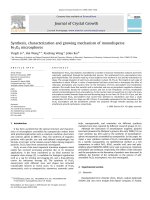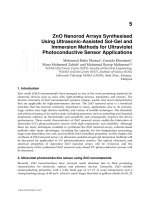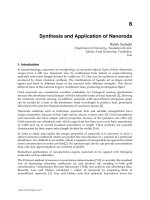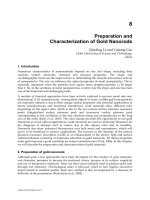Synthesis, characterization and self assembly of stimuli sensitive materials
Bạn đang xem bản rút gọn của tài liệu. Xem và tải ngay bản đầy đủ của tài liệu tại đây (5.53 MB, 232 trang )
SYNTHESIS, CHARACTERIZATION AND SELF-
ASSEMBLY OF STIMULI SENSITIVE MATERIALS
SATYANANDA BARIK
(M. Tech. IIT Kharagpur,
M. Sc. Utkal University, India)
A THESIS SUBMITTED
FOR THE DEGREE OF DOCTOR OF PHILOSOPHY
DEPARTMENT OF CHEMISTRY
NATIONAL UNIVERSITY OF SINGAPORE
2009
ACKNOWLEDGMENTS
I would like to express my gratitude to my supervisor, Assoc. Prof. Suresh
Valiyaveettil for his guidance, constant support and encouragement throughout the
research project.
I sincerely thank Dr. Akhila, Dr. Raj, Dr. Aji, Dr. Vetri, Dr. Santhosh, Dr. Anideepthi,
Dr. Manoj, Dr. Jinu, Dr. Sindhu, Dr. Siva, Dr. Renu, Dr. Gayathri, Dr. Rajeev, Asha,
Sheeja, Hairong, Fathima, Haiyu, Balaji, Jhinuk, Pradipta, Narahari, Thirumal, Kavitha,
Yiwei, Nizar, and Kiruba for their cordiality, friendship and for exchanging knowledge
skills. Special thanks to Dr. Akhila who helped me first in laboratory to know more about
synthesis; Dr. Nurmawati, and Dr. Sindhu for helping me obtain the TEM images; Dr.
Jegadesan, and Sajini for their assistance in using the AFM. I am thankful to Ankur for
helping me in SEM and XRD.
My appreciation goes to Sheena and Karen, former Honors students and Radhika,
former M.Sc. student for their patience and assistance in performing synthesis.
I must acknowledge the technical assistance provided by the staff of the NMR, Mass
spectroscopy, Elemental Analyses and Thermal Analysis Laboratories at NUS.
Cheers to my buddies, Amarendu Da, Swopnil, Sujit, Manoj Manna, Ankur, Santosh,
and Pradipta, whose constant companion never failed to light up my days in Singapore.
The gratitude that is most difficult to express in words is towards my family. I
wholeheartedly thank my parents, brothers, sister, and sister-in-laws for their support and
encouragement. They loved me, taught me and showed me how to make sense of the
world. To my pillars of support, I dedicate this thesis.
I thank the National University of Singapore for granting the research scholarship.
i
TABLE OF CONTENTS
Acknowledgments
i
Table of contents
ii
Summary
viii
Abbreviations and Symbols
x
List of Tables
xiv
List of Figures
xvi
List of Schemes
xxii
1 Introduction
1
1.1 Supramolecular Chemistry
2
1.2 Supramolecular Polymer Chemistry: An Overview
4
1.2.1 Fabrication of nanostructure materials 4
1.2.2 The macromolecular assembly 6
1.3 Block Macromolecular Self-assembly: A Recent Study
11
1.4 Precursor Copolymer Approach
17
1.4.1 Structural organization of precursor polymer 17
1.4.2 Controlled radical polymerization techniques 25
1.4.3 Electrochemical Nanolithography 26
1.5 Semiconducting Supramolecular Macromolecules
26
1.6 Photo-chromic Molecules and Morphosyntheses
38
1.7 Aim and Outline of This Thesis
43
1.8 Notes and References
45
ii
2 Synthesis and Self-assembly of Copolymers with
Pendant Electroactive Units
61
2.1 Introduction
62
2.2 Experimental Section
63
2.2.1
Synthesis
63
2.3 Results and Discussion
66
2.3.1 Synthesis and characterization of copolymers (P1-P4) 66
2.3.2. Thermal properties 68
2.3.3. Optical properties 68
2.3.4. Nano-fiber morphology studies 70
2.3.5. Electrochemical nano-patterning using AFM 73
2.3.6. Electrochemical polymerization using CV 75
2.4 Conclusion
80
2.5 References
81
3 Diblock Copolymer Assemblies Through Changes
in Amphiphilicity of Pendent electroactive Moiety
87
3.1 Introduction
88
3.2 Experimental Section
89
3.2.1 Synthesis 89
3.3 Results and Discussion
89
3.3.1. Synthesis and characterization of block copolymer 89
3.3.2. Thermal properties 94
iii
3.3.3. Optical Properties 95
3.3.4. Self-assembly of block copolymers 96
3.3.5 Electrochemical polymerization 101
3.4 Conclusion
107
3.5 References
108
4 Engineering Nano-architectures of Amphiphilic
Dithienylethene (DTE): Synthesis and
Characterization
112
4.1 Introduction
113
4.2 Experimental
113
4.2.1 Synthesis
113
4.3 Results and Discussion
114
4.3.1 Design, synthesis and characterization 114
4.3.2 Photochromism 118
4.3.3 Self-assembly and morphology 124
4.4 Conclusion
129
4.5 References
130
5 Regioregular Electro-active Carbazole End-
Capped Oligo(p-phenylene): Synthesis,
Characterization and Self-assembly Studies
134
5.1 Introduction
135
5.2 Experimental
135
iv
5.2.1 Synthesis 135
5.3 Results and Discussion
136
5.3.1. Design, synthesis and characterization 136
5.3.2. Thermal properties 140
5.3.3 Optical properties 141
5.3.4 Electrochemical properties 144
5.3.5 Self-assembly and microphase separation 145
5.4 Conclusion
150
5.5 References
151
6 Conjugated Polymer Network Self-assembled
Films From Precursor Polymers: Cross-
conjugated Poly (p-phenylene)
155
6.1 Introduction
156
6.2 Experimental Section
158
6.2.1 Synthesis
158
6.3 Results and Discussion
159
6.3.1 Synthesis and characterization 159
6.3.2 Optical properties 162
6.3.3 Thermal properties 164
6.3.5 Electropolymerization 165
6.3.6 Morphological characterization of electropolymerized film 168
6.4 Conclusion
169
6.5 References
170
v
7 Experimental Section
174
7.1 General Instrumentation
175
7.2
Synthesis of Compounds in Chapter 2 176
7.2.1 General procedure for synthesis of monomers (3, 5, 7, 9 and 11) 176
7.2.2 General procedure for free radical copolymerization (P1-P4) 179
7.3
Synthesis of Compounds in Chapter 3 181
7.3.1 Synthesis of monomer 6 181
7.3.2 Homopolymerization of 15 {PBMMA-Br (18)} 182
7.3.3 General procedure of atom transfer radical polymerization (ATRP)
for block copolymer synthesis
183
7.4
Synthesis of Compounds in Chapter 4 185
7.4.1 General synthesis of intermediates 185
7.4.2 General procedure for diazo-compound synthesis 188
7.4.3 General procedure for the synthesis of azo-dithienylethene (DTE)
molecules
189
7.5
Synthesis of Compounds in Chapter 5 191
7.5.1 Synthetic procedures of intermediates 191
7.5.2 General procedure for O-alkylation 191
7.5.3 General Procedure of boronicacid syntheses 192
7.5.4 General procedure for Suzuki coupling reaction 194
7.5.5 General procedure of Buchwald coupling for the synthesis of
OLG1-OLG4
197
7.6
Synthesis of Compounds in Chapter 6 199
7.6.1 General procedure for selective bromination of thiophene 199
7.6.2 Synthesis of intermediates 200
7.6.3 General procedure of Wittig reaction 202
vi
vii
7.6.4 General procedure of Suzuki polymerization (P1-P3) 204
7.7
References 206
Appendix I
List of Publications
207
Summary
The focus of this thesis involves the design and synthesis of multidimensional (1D -
2D) organic macromolecules with redox or photo-active groups that assists in the self-
assembly process. Synthesis, characterization, and self-assembly of polymethacrylated
amphiphilic copolymers were achieved. Copolymers with varying spacers between the
backbone and the electroactive groups, the self-assembly properties were investigated.
The intermolecular interactions are important towards the self-assembly of polymers and
the target polymers gave nanofiber morphology in the solid state. The nature and
orientation of the pendant electroactive groups play a crucial role for the selective
morphogenesis. The electropolymerization of the electroactive groups led to the formation
of conjugated polymer network (CPN) in the polymer lattice. This concept was
investigated in Chapter two.
In Chapter three, the multi-functional amphiphilic block copolymers were
synthesized with pendant electroactive groups and polyhydroxylated moieties using ATRP
method. The block copolymers self-assembled from water/THF mixture through
microphase separation of polar and nonpolar blocks to give lamellar or vesicular
morphologies depending on the structure of the polymer backbone. The
electropolymerization of the groups on the side chain showed formation of conjugated
polymer network (CPN) on ITO.
In Chapter four, synthesis of photoactive (diazo) and photochromic (dithiaethylene)
moelcuels were discussed. The photochromism and self-assembly of the compounds were
explored. The formation of well defined nanorings and role of concentration and surface
viii
ix
on ring formation were investigated. The thermal stability of nano-rings through annealing
showed that the rings were stable at high temperature.
In
Chapters five, a series of carbazole (electroactive) end-capped oligo- (p-phenylene)
was synthesized using Buchwald’s double amination reaction and characterized and
optical and electrochemical behaviour were investigated. The materials showed hole
transport characteristics. The molecular aggregations in THF/H2O solvent mixture were
investigated using electron microscopy. The structure-property correlation between
photophysical properties and crystalline domain formation of the homologous series of
oligomers are described.
In Chapter six, the roles of conjugated segment of soluble cross-conjugated polymer
poly (p-phenylene) with electroactive groups were discussed. The cross-conjugated poly-
(p-phenylene) with electron donor/acceptor (e.g. thiophene/carbazole) groups was
synthesized and photophysical/electrochemical properties were investigated to establish
the cross talking of electrons form the multiple branches of the molecule. The fabrication
of nanofibers from thiophene incorporated on the poly (p-phenylene) backbone was
demonstrated.
Details of the synthesis, characterizations of the intermediates and target compounds
along with the various other instrumentation techniques mentioned in this thesis are given
in Chapter seven.
ABBREVIATIONS AND SYMBOLS
1D One Dimensional
2D Two Dimensional
3D Three Dimensional
1
H-NMR Proton Nuclear Magnetic Resonance
13
C-NMR Carbon Nuclear Magnetic Resonance
Å Angstrom(s)
δ
Chemical shift (in NMR spectroscopy)
Φ Fluorescence quantum yield
τ
Measured fluorescence lifetime
τ
nrad
Non-radiative lifetime
Γ
Rate constant for fluorescence decay
τ
rad
Radiative lifetime
λ
Wavelength
θ Diffraction angle
ca.
About
AFM Atomic Force Microscopy
b Broad
BuLi Butyllithium
CHCl
3
Chloroform
CLSM Confocal Laser Scanning Microscope
conc.
Concentrated
CV Cyclic Voltammetry
CP Conjugated Polymer
x
d Doublet
dd Double of Doublet
DCM Dichloromethane
DLS Dynamic Light Scattering
DP Degree of Polymerization
DMF Dimethylformamide
DMSO Dimethylsulfide
D
2
O Deuterium Oxide
EA Ethyl Acetate; Elemental Analysis
EI-MS Electron Impact Mass Spectrometry
ESIPT Excited State Intramolecular Proton Transfer
EtOH Ethanol
FS Femtosecond
GPC Gel Permeation Chromatography
HBC Hexa-peri-hexabenzocoronene
Hz Hertz
FT-IR Infrared Fourier Transform
hr Hour(s)
i.e. That is (Latin id est)
J Coupling constant
KBr Potassium Bromide
K
2
CO
3
Potassium Carbonate
K
sv
Stern-Volmer constant
LED Light Emitting Diode
xi
LB Langmuir-Blodgett
m Multiplet
m/z Mass/Charge
MeOH Methanol
mg Milligram(s)
mN/m milliNewton/meter
mL Milliliter(s)
mmol Millimol
MW Molecular Weight
NBS N-bromosuccinimide
nm nanometer
OBn O-Benzyloxy
OM Optical Microscope
OPA One Photon Absorption
OPP Oligo(para-phenylene)
PA Polyacetylene
PANI Polyaniline
Pd(0)P(Ph
3
)
4
Tetrakis(triphenylphosphine)Palladium(0)
Pd/C Palladium on Carbon
PDI PolyDispersity Index
PF Polyfluorene
PL Photoluminescence
PPE Polyphenyleneacetylene
PPP Poly(p-phenylene)
xii
xiii
PPS Poly(phenylene sulphide)
PPV Polyphenylenevinylene
PPY Polypyrrole
PT Polythiophene
ps Picosecond
QY Quantum Yield
q Quartet
ROS Reactive Oxygen Species
RT Room Temperature
s Singlet; Second
SEM Scanning Electronic Microscope
t Triplet
t
t
Transit time
TCSPC Time-Correlated Single-Photon Counting
TEAC Trolox Equivalent Antioxidant Capacity
TEM Transmission Electron Microscope
TGA Thermo Gravimetric Analyzer
TMS Tetramethylsilane
THF Tetrahydrofuran
TLC Thin Layer Chromatogharphy
TPA Two Photon Absorption
UV-vis Ultra-Violet Visible spectroscopy
WSP Water Soluble Polymer
XRD X-Ray Diffraction
Table No.
LIST OF TABLES
Page
No.
Chapter 1
Table 1.1
“Precursor polymers” based on single or binary tethered
electroactive monomers.
19
Table 1.2
End-capped conjugated polymers and oligomers 28
Table 1.3
Cross-conjugated polymers and oligomers 32
Chapter 2
Table 2.1
Structural characteristics of copolymers P1-P4 67
Table 2.2
The absorption and emission wavelengths for copolymers P1-P4
in THF
70
Table 2.3
X-ray diffraction data for copolymer P2 72
Chapter 3
Table 3.1
Structural characteristics of polymers PFlMMA-b-PBMMA and
PCzMMA-b-PBMMA
93
Table 3.2
X-ray diffraction data of block copolymer PCzMMA-b-PBMMA
and PFlMMA-b-PBMMA
100
Chapter 4
Table 4.1
Photophysical properties of DTE-Ph and DTE-Naph in CHCl
3
120
xiv
xv
Chapter 5
Table 5.1
Summary of physical measurements of OLG1-OLG4 143
Table 5.2.
Observed and calculated reflections from X-ray diffraction data at
room temperature of self-assembled OLG1
149
Chapter 6
Table 6.1
Physical properties of copolymers P1-P3 162
Figure No. LIST OF FIGURES
Page
No.
Chapter 1
Figure 1.1
Schematic representations of nanostructure fabrication;
lithography (a) and self-assembly (b).
5
Figure 1.2
Mesoscopic assemblies and Packing parameter representation
(Redraw from Nature Materials 2005, 4, 729)
7
Figure 1.2.1
Schematic representations of bilayer supramolecular assemblies;
micelles (a), vesicles (b) and lamellae (c).
9
Figure 1.3
Schematic representations of supramolecular assemblies;
columnar stacking (a), helical (b) and tubular (c).
10
Figure 1.4
Schematic representations of copolymer morphologies. The
volume fraction of one component increases from left to right.
The morphologies are body-centered cubic spheres (BCC),
hexagonally packed cylinders (H), gyroid (G), double gyroid
(DG), lamellae (L).
12
Figure 1.5
Morphologies of PB-b-PEO in water. Four basic structural
motifs—bilayers (B), Y-junctions (Y), cylinders (C), and
spheres (S); cryo-TEM, micrographs (From left to right);
vesicles, Y-junctions, and wormlike micelles.
14
Figure 1.6
Amphiphilic comb-dendronized block copolymers P(PEOMA)-
b-DPS and its liquid crystalline property and self assembly in
THF/MeOH solution.
16
Figure 1.7
Schematic representations of grafted precursor polymers;
PMMA-g-PPY (a) and PMMA-g-PTh (b).
19
Figure 1.8
Photochromism; stilbene (1), diarylethenes with thiophene rings
(2), and perfluorocyclopentene with thiophene rings (3).
41
Figure 1.9
Structure of dithienylethene-pyrene diad (a) and dithienylethene-
pyrene-dithienylethene triad (b) showed 2D structural order.
42
xvi
Chapter 2
Figure 2.1
Molecular structure of copolymers (P1-P4). 63
Figure 2.2
FT-IR spectra of copolymer P1-P4. 67
Figure 2.3
TGA (A) and DSC (B) of copolymers; P1 (▲), P2 (¡), P3 (Ì),
and P4 (½) at heating rate of 10 °C/min under N
2
atmosphere.
68
Figure 2.4
Absorption (A) and emission spectra (B) of copolymers in THF
solution; P1 (▲), P2 (¡), P3 (Ì), and P4 (½).
70
Figure 2.5
TEM images of nanofibres formed by self-assembly of
copolymers (P2) in 0.01mg/mL.
71
Figure 2.6
X-Ray diffraction pattern of the copolymer (P2) film on glass
slide.
72
Figure 2.7
Schematic representation of molecular self-assembly through
aggregation of polymer chains and π – π stacking of the
electroactive groups on the side chain.
73
Figure 2.8
Nanopatterning of polymer (P3) film at various tip bias (a)
and
tip speed (b). Dot patterning on polymer film at various tip bias
(c) and contact time (d).
74
Figure 2.9
CV for electrochemical polymerization (cross-linking) of spin
coated polymer film in ITO substrate; P1 (A), P2 (B), P3 (C),
and P4 (D) at the scan rate 50 mV/s.
76
Figure 2.10
Polymer free scan of polymer films; P1 (A), P2 (B), P3 (C), and
P4 (D).
77
Figure 2.11
UV-vis spectra of electropolymerized thin film copolymers; P1
(A), P2 (B), P3(C), and P4 (D); precursor Polymers (▲) and
electropolymerized thin films ().
78
Figure 2.12
FT-IR spectra of electrochemical cross-linking polymer film
with precursor polymers; P1 (A), P2 (B), P3 (C), and P4 (D);
precursor-polymer () and after electropolymerization (▲).
79
xvii
Figure 2.13
Mechanism for the electropolymerization (cationic) and cross-
linking of P2.
80
Chapter 3
Figure 3.1
Molecular structure of diblock copolymers (PCzMMA-b-
PBMMA and PFlMMA-b-PBMMA).
89
Figure 3.2
GPC curve (a) and FT-IR spectra (b) of block copolymers in
KBr; PFlMMA-b-PBMMA (▲), PCzMMA-b-PBMMA (Ì).
93
Figure 3.3
Thermogravimetry analysis (TGA) of PFlMMA-b-PBMMA
(▲) and PCzMMA-b-PBMMA (Ì); protected (a) and
deprotected (b) in N
2
atmosphere with a heating rate of 10
ºC/min.
94
Figure 3.4
Absorption (a) and emission (b) spectra (excitation at 290 nm) of
PCzMMA-b-PBMMA (▲) and PFlMMA-b-PBMMA (¡).
95
Figure 3.5
SEM micrographs of block copolymers; PCzMMA-b-PBMMA
(a) and PFlMMA-b-PBMMA (b).
97
Figure 3.6
TEM images of block copolymers: PCzMMA-b-PBMMA (a)
and PFlMMA-b-PBMMA (b).
98
Figure 3.7
X-ray diffraction pattern of diblock copolymer; PCzMMA-b-
PBMMA (a) and PFlMMA-b-PBMMA (b) on a glass slide.
99
Figure 3.8
Schematic diagram of microphase separation according to the
amphiphilicity of block copolymers.
99
Figure 3.9
Ten cycles of CV for electrochemical polymerization of block
copolymers; PCzMMA-b-PBMMA (a) and PFlMMA-b-
PBMMA (b). Polymer free scans for block copolymers after
electropolymerization of PCzMMA-b-PBMMA (c) and
PFlMMA-b-PBMMA (d).
102
Figure 3.10
Linearity of current with number of scans of
electropolymerization of block copolymers; PCzMMA-b-
PBMMA (a) and PFlMMA-b-PBMMA (b).
103
xviii
Figure 3.11
Absorption and emission spectra of electropolymerized
deposited film on ITO with precursor block copolymers;
PCzMMA-b-PBMMA (a, b), PFlMMA-b-PBMMA (c, d).
Precursor polymer (▲) and electropolymerised film (Ì).
105
Figure 3.12
ATR-FTIR spectra of block copolymers PCzMMA-b-PBMMA
(▲) & PFlMMA-b-PBMMA (); precursor polymer (a) and
after electropolymerization (b).
105
Figure 3.13
Increase in absorption peak during electropolymerization (CV)
of block copolymers at different number of cycles; 3 (▲), 5
(), 10 (), and 15 (¡); PCzMMA-b-PBMMA (A) and
PFlMMA-b-PBMMA (B).
106
Figure 3.14
AFM images of conjugated polymer network film of 10 cycles
on ITO; PCzMMA-b-PBMMA (a) and PFlMMA-b-PBMMA
(b).
107
Chapter 4
Figure 4.1
Structural representation of amphiphilic dithienylethene DTE-
Ph and DTE-Naph.
114
Figure 4.2
FT-IR spectra of target molecules; DTE-Ph () and DTE-Naph
(▲).
118
Figure 4.3
Absorption (A and C) and emission (B and D) spectra of
dithienylethenes photochromism in chloroform solution; DTE-
Ph (A and B) and DTE-Naph (C and D).
121
Figure 4.4
Change in the color upon irradiation of azo-thienylethenes;
DTE-Ph (a) and DTE-Naph (b).
121
Figure 4.5
Change in the UV-vis absorption (A) spectra (recorded at 625-
640 nm) and normalized emission (recorded at 595 nm) for
chloroforms solution of DTE-Ph and DTE-Naph when
irradiated with 356 nm light over 900s period [absorption (▲)
and emission (Ì) of DTE-Ph; absorption (¡) and emission
()] of DTE-Naph. Normalized emission (B) as a function of
normalized absorption for solution of DTE-Ph (▲) and DTE-
Naph (¡) at 10
-5
M.
122
Figure 4.6
Cyclic voltammogram of photochromic dithienylethene
molecules; before (▲) and after () irradiation of DTE-Ph (a)
123
xix
and DTE-Naph (b).
Figure 4.7
Photo-conductivity (I-V) characteristics of DTE-Ph (a) and
DTE-Naph (b); (▲) before and () after irradiation.
123
Figure 4.8
AFM images of azo-dithienylethenes on mica substrate; DTE-
Naph (a) and DTE-Ph (b).
124
Figure 4.9
AFM images of azo-dithienylethenes on Si (111) substrate;
DTE-Ph (a - b) and DTE-Naph (c - d).
126
Figure 4.10
AFM images of DTE-Naph at different concentration on Si
(111) substrate; 1.2 x 10
-3
(a) and 1.05x 10
-8
M (b).
127
Figure 4.11
AFM images of DTE-Naph film on Si (111) surface annealed at
120 °C for 2 h
127
Figure 4.12
Absorption (a) and emission (b) spectra of DTE-Naph in
chloroform; solution (▲) and nano-rings () on Si (111)
substrate.
128
Figure 4.13
1
H NMR of – OH proton; DTE-Ph (a) and DTE-Naph (b).
129
Figure 4.14
Schematic representation of self-assembled DTE-Naph
molecule into columnar stacks.
129
Chapter 5
Figure 5.1
Designed molecular structure of oligomers (OLG1-OLG4). 136
Figure 5.2
FT-IR spectra of target molecules OLG1 – OLG4. 140
Figure 5.3
Thermal properties of OLG1 (▲), OLG2 (¡), OLG3 (Ì), and
OLG4 (½); TGA (A) and DSC (B) (2
nd
heating) at heating rate
of 10 min/ ⁰C in N
2
.
141
Figure 5.4
Absorption and emission spectra of OLG1 (▲), OLG2 (¡),
OLG3 (Ì), and OLG4 (½); THF solution (A) and thin film (B)
in quartz surface.
142
Figure 5.5
CV curves of OLG1-OLG4 measured in CH
2
Cl
2
containing n- 145
xx
Bu
4
NPF
6
as supporting electrolyte at a scan rate of 50 mV/s.
Figure 5.6
Absorption (a) and emission (b) spectra of OLG1 in THF/water
solution.
146
Figure 5.7
Scanning electron microscope (a, b) and transmission electron
microscope (c, d) images of nano-rods formed by self-assembly
of OLG1 in aqueous solution (THF: H
2
O).
147
Figure 5.8
XRD patterns of OLG1; powdered (▲) and self-assembly ()
sample drop casted on glass cover slip
148
Figure 5.9
Proposed supramolecular assembly through side-chain
association of OLG1.
150
Chapter 6
Figure 6.1
Structure of the target copolymers P1-P3. 157
Figure 6.2
FT-IR spectra of copolymers P1 (▲) and P2 (). 162
Figure 6.3
Absorption (a) and emission (b) spectra of polymers in THF
solution; P1 (), P2 (z), and P3 (▲).
163
Figure 6.4
Absorption (a) and emission (b) spectra of polymers in thin film; P1
(), P2 (z), and P3 (▲).
164
Figure 6.5
Thermogravimetry analysis (TGA) of cross-conjugated
copolymers; P1 (▲), P2 (¡), and P3 (Ì) at heating rate of 10
°C/min under N
2
atmosphere.
165
Figure 6.6
CV for electrochemical cross-linking film; P1 (a), P2 (b), and
P3 (c) followed by their linearity curves P1 (d), P2 (e), and P3
(f).
167
Figure 6.7
AFM morphologies of polymers in THF on ITO substrate before
electropolymerization; P1 (a), P2 (b), and P3 (c).
169
Figure 6.8
Tapping-mode AFM topography images of P2 after
electropolymerized on ITO at scan rate of 100 mV/s; flatten
nano-fibers (a-b).
169
xxi
xxii
Scheme No.
LIST OF SCHEMES Page
No.
Chapter 2
Scheme 2.1
General synthetic approach to monomers. 64
Scheme 2.2
General synthetic approach to copolymers (P1-P4). 65
Chapter 3
Scheme 3.1
Synthetic procedures for monomers. 90
Scheme 3.2
Synthetic procedures for homopolymer and block-copolymers. 91
Chapter 4
Scheme 4.1
General synthetic strategy for target DTE-Ph. 116
Scheme 4.2
General synthetic strategy for target DTE-Naph. 117
Chapter 5
Scheme 5.1
General synthetic strategy of compounds (28-35). 138
Scheme 5.2
General synthetic strategy of compounds (36-41). 139
Scheme 5.3
Synthesis of targets oligo (p-phenylene) OLG 1- OLG4.
139
xxii
xxiii
Chapter 6
Scheme 6.1
Synthetic procedures for thiophene based monomers (M1-M2). 158
Scheme 6.2
Synthetic procedures for monomer M3. 160
Scheme 6.3
Synthetic procedure for copolymers P1-P3.
161









